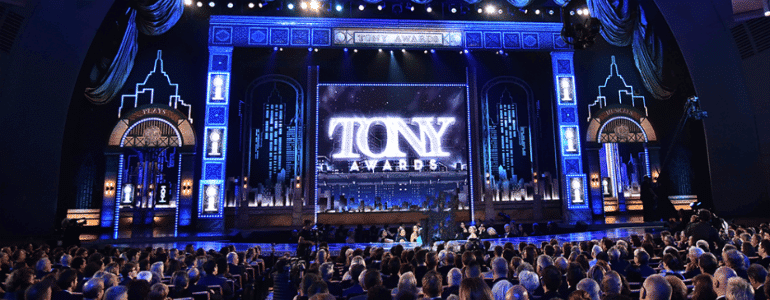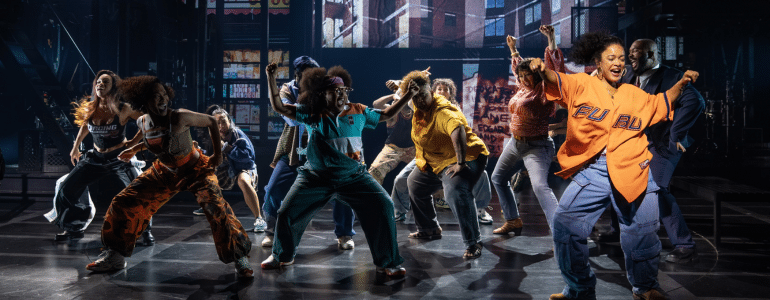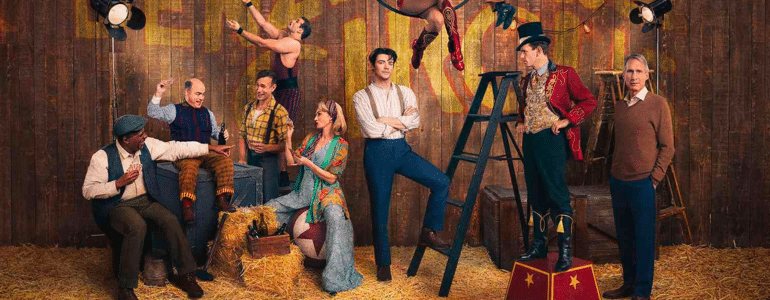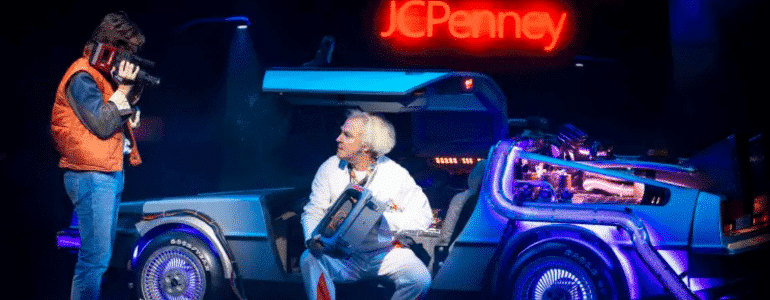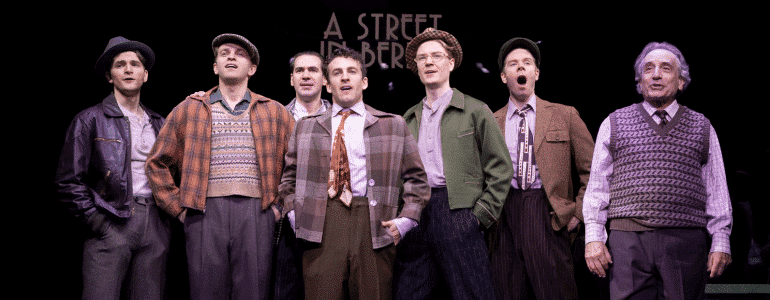Podcast Episode 63 Transcript – Christopher Gattelli
Ken: Hey, everybody. In case you missed it, we unveiled a new section of the website last week. The Producer’s Perspective Pro has all sorts of cool stuff for people like you that are looking to take their shows to the next level. Check it out – training modules, labels for mailings and a free webinar every month with me, including one this coming Wednesday about how to raise that holy grail of capital, front money. The Producer’s Perspective Pro – check it out on the blog, and now on with the podcast.
Ken: Hello, everybody! Welcome back, or if this is your first time here, welcome to the Producer’s Perspective Podcast. I am Ken Davenport and today I’m happy to have as my guest Tony award winning choreographer Christopher Gattelli. Welcome, Chris!
Chris: Thank you so much, Ken.
Ken: So Chris won his Tony for the incredible athletic choreography in Newsies. Also nominated for his work in South Pacific and he choreographed The King and I, Amazing Grace, off-Broadway’s Bat Boy with the most inspired Lion King bit ever, and I’ve been fortunate enough to work with him three times, on 13, Godspell and Altar Boyz. He’s one of the first names thought of when any producer out there today is considering hiring a choreographer for a new musical, he’s doing more and more directing including that surprise hit of a few years ago, Silence! The Musical, which was hysterical. So, Chris, let’s go back a few years – how did you get started in the business in general?
Chris: In general, I started out as a performer and my first thing in the city was Radio City Musical Hall Christmas Spectacular.
Ken: You were a Rockette.
Chris: Yes, I was the third from the end. No, I was a dancing tree and a teddy bear, but it was great and I made some nice connections through that show and, from that, did Guys and Dolls, the national tour of that, and, again, it’s that snowball of what we do, you get to know people and work with people and, from that, I did Cats and How to Succeed here in the city and a bunch of stuff.
Ken: When was the moment when you said, “Okay, I no longer want to just do these steps, I want to design these steps.” Do you remember when that happened for you?
Chris: I do. I knew the seed was planted when I worked with Chris Chadman on Guys and Dolls. There was a way that he had of working – actually I think it was both, it was Chris Chadman and Scott Salmon who did the Christmas show, they both were so inspiring in different ways. Chris was an incredible storyteller, incredible athleticism, incredible detail, and then Scott was from the school of just showmanship and comedy and their touches were completely different but both so inspiring and I worked with them in the same year. It was more Chris but they both had a huge impact on me and it was Chris and I knew I would perform but I knew it wasn’t going to be long before I dipped my toe in the other waters, I could feel it.
Ken: So how did you start that process of transitioning from dancer to choreographer?
Chris: It’s interesting, I assumed that there would be a process, like I would be an assistant dance captain and then a dance captain and then an associate on someone’s show and then collaborate with someone and this chance coincidence opportunity happened where I did a number for “Gypsy of the Year” for Broadway Cares, it’s one of their annual fundraising events – they do two a year for the Broadway community – and I did a number for Cats for “Gypsy of the Year” and they liked our number and asked me to do the opening number of the Easter bonnet that following season and, again, there were all of these stars aligning – we had five of the original Ziegfield Folly ladies come back, they were opening the New Amsterdam stage with this show, so five of the Ziegfield Follies went bac and Rosie O’Donnell was a guest judge, just all of these great things were happening and it all went of really, really well and from that Rosie O’Donnell offered me a spot to choreograph for her TV show, which at the time was really big and I had never done TV but I’m a hard worker and I figured it out really fast. From then doors opened because of that opportunity that I didn’t expect to happen for years. So I was performing, I was still doing Cats at the time, and I was double dutying – I was doing her show in the early morning and doing the show at night and that kind of kept up for a few years and then Bat Boy came along. This doesn’t sound too different from what’s happening now but then Bat Boy came along and it was my first New York musical and I knew it had potential to be this really great show and special and I kind of wanted to give it my full focus so I stopped performing for a bit and I just did that, which was great, and then that led to tick, tick… BOOM! and then that snowball started going really quickly so I just kept going.
Ken: We’re going to get back a little bit to your history but since you mentioned television and you had never done TV before, what are the differences between designing dance for the stage and for television or film? You’re doing a lot of film work as well now, right?
Chris: Yeah, it’s different in that on stage it’s a different craft where you have to tell the audience member where to look. If you’re trying to tell a story on stage you have a proscenium, a box that you’re doing it in, and so if I want to make sure that they’re following this couple’s story then I need them all to look stage left when they need to look stage left and follow that couple in the midst of this dance number or something, so it’s a much bigger lens you have to work in so you always have to tell the audience where, collectively, to follow your story, whereas in film you literally get to tell them where to look, you get to pan right when something important is happening or you get to go 360 degrees around a body to get a shot or a look. They’re both fun and challenging in their own ways. It was interesting going from stage to TV/film because you’re just used to working with directing the eye all the time and you’re trying to tell a story in that way so to have that kind of endless like, “Oh, we can shoot from the ceiling, we can have the perspective from the feet,” it’s just that many more options and things you have to think about, which is great on that other hand because it’s fun to play with all of those different options.
Ken: So how do you prepare for a project? We’ll talk about Altar Boyz, my first show, you’re doing a boy band musical but what’s the first step for you and how does that differ to doing The King and I? What are your first steps when you get a job?
Chris: The first definitely is talking to the director to kind of line up sensibility. For me, that’s the most important thing because I truly look at it as I’m an extension of them, like I am there just like all the other designers to support their vision for the show, so it’s making sure that whatever they’re hoping to get across with the show, whatever their bigger idea is, that I’m there to support that. So that is always first and foremost, and then from there, once they tell me, like with Altar Boyz Stafford would say, “Okay, we’re doing boy bands but it’s for real, we’re not goofing this up, it’s totally honest, it’s totally real, the look’s got to be great, we’re not making fun,” and that’s a very specific direction to go in and then you just study that genre of whatever show you’re working on. Again, in that case, I watched a million NSYNC videos and Backstreet Boys videos and concerts, so it’s all of that, it’s research. Again, those two specific examples and directors, Staffard and Bartlett, who did South Pacific and The King and I, I can go into a room with Stafford and I can have the number done and I can have the number completely prepared and set and kind of watch how it builds and I don’t want to say manipulate it but I can kind of score the number and let it build and find out where the laughs are and then present it to him and then he’ll have notes and we’ll collaborate and go based on our ideas, whereas Bartlett is completely the opposite, Bart just says, “Do your research and then we’ll make it up in the room,” which, the first time I had to do that was absolutely terrifying.
Ken: I’m scared!
Chris: And that was the first time, like the same thing in Bat Boy, you go in and it’s like, “Okay, I’m going to have this one and this one,” you just score it and that’s always how I used to work. With Bart, though, he just said, “Do all of your research and then come in, because if you do your research then you’ll have the answers,” and there are 40 people looking at you make stuff up on the spot and you’re like “Okay, we’re all going to march across the dune this way,” or “Let’s throw this person this way!” It was much more organic but it really opened my self-confidence up and that if you do do the work, if you do do the research, if you do know the period, the style, that ultimately you’re creating a visual story so it’s going to come out, it’s going to happen, and then, once you have the blueprint you go back and you rescore it but it’s definitely opened my way of working because I used to go in, Ts crossed, Is dotted, everything was done, but it let me feel confident to walk into a room with actors and any collaborator, really, and be like 75% done or maybe I have a secret 90% done that they don’t know about.
Ken: You cheated, come on!
Chris: But it definitely opened me up to that kind of thinking and I think it’s really helped just me as a creative. It’s helped so much.
Ken: It’s got to be so scary but at the same time so rewarding and so fresh.
Chris: Yeah, and also you’re creating it on the people in the room, and I’ve learned that too – it’s not “Oh, you go here,” it’s “Let’s talk about how you would get there and why.” It’s much richer, it’s definitely richer.
Ken: That’s a very interesting point because I remember this from the times I’ve sat in an audition room with you – you’re one of those choreographers that seems to look at you like, “Don’t worry, this actor is so good, this singer is so good, I can make them move, don’t worry about it,” whereas other people are like, “I have to have this dancer who can take this leg and move it this far above their head.” So what do you look for when you’re auditioning? Are you like, “They’ve got to have that pirouette, it’s got to be a triple in three seconds,” or whatever – I’m not a dancer! What do you look for?
Chris: I think, again, depending on the show. Overall, the thing that I look for is focus and being present. When they walk in a room, if they’re just connected, if there’s something going on behind their eyes. I’m not married to steps, I don’t think steps are the be all and end all; it’s about telling the story, it’s about using the actors you have to tell it, to me. So I don’t care if someone kicks on their right leg or their left or they can’t do a triple, I don’t care. I’d rather create it on the bodies and on the actors that I’m working with. Newsies was very specific because that’s what it was – you had twenty boys at that age physicalizing what they had to do and so, yeah, they’re going to do three turns or seven or however many they wanted to do. In that specific case then, yes, you need boys to be technically proficient – not for me but for their health and safety. I can tell anyone to turn three times but if they’re not going to do it well someone’s going to get hurt, so for certain things you have to check some boxes in that way just to make sure that they can sustain an eight show week, which is always hard, but even more so it’s just are they present, are they in the room with me, did they listen to the tone? “Okay, we’re doing this and this is why,” are they getting that or are they just kind of in the room showing off? So mainly it’s always about being present.
Ken: How much do you – we’ll get to the director part in a minute – but as a choreographer how much do you like to work with the writers on a new piece or how much do you think you should? I’ll tell everyone a little story out of school – at 13 I remember you coming to me and being like, “Hey, Ken, you should take a look at this, I’ve got some ideas,” which I loved and we ended up doing a lot of those ideas, so how much do you like to be involved in that process?
Chris: I love it as much as they’ll listen. As much as anyone will listen because I mean everyone has thoughts and everyone has ideas and I think there are also ways, physically, that I feel like I can contribute that might not be apparent to someone who’s literally just thinking of the word and the lyric – there are ways to tell stories in other ways that I feel like I enjoy doing and I can do so I always love being at the ground level because if I can help in any way as part of the team it’s better to get it on the ground level than have to go down the road and then it’s like, “Ah, now what do we do at this moment?” where maybe I could have helped earlier in the process or something.
Ken: Do you like working on new shows versus revivals, one or the other?
Chris: I love them both. I love getting to work on something new because you’re getting to create and getting to leave your stamp on something, like Altar Boyz, that was one of the best gigs because to get to do something like Altar Boyz and it’s being done everywhere now and to know that “Wow, they might be doing some of that because of me,” because they might be putting lambs on their hands because I wanted lambs on their hands. It just feels really good to think that you leave a mark in that way and that’s really fun, but also the challenge of taking a revival and trying to find what makes it relevant, how to put a new sheen on something. I like the challenge of hearing a dance break and hearing orchestrations and hearing a trumpet or hearing an instrument in an original dance break and going, “I wonder what was that was for?” and making it mean something to me. It’s like a crossword puzzle in a way. So they both have their really fun challenges and rewards.
Ken: So Fosse had a style, Bennett had a style – does Christopher Gattelli have a style?
Chris: I don’t. It’s funny, I feel like at the start of this, when I was starting out, I was like, “What’s my thing?” My jazz hands or whatever, but what I hope it is, is diversity, that you can say that I’ve done The King and I and Altar Boyz, I love being able to dip into every pond. For example, when I did The Jungle Book a few years back it was a fusion of jazz and Bharatanatyam, Indian dance – I’ve never done that and it was great and I love that part of the research, working with a teacher and learning what the steps are and making it my own, so it feels like it’s never going to get boring to me, I’ll always be challenged by something if I don’t have a stamp or a style, I love playing all over the place.
Ken: The diversity of the material you’ve done is quite amazing. I’ll never forget that Bat Boy moment and then, to see something like South Pacific, it’s really incredible how you morph your style into many different productions. So now you’re on to directing as well. Before we even get into you, some of Broadway’s best musical directors started out as choreographers, like some of those names I just mentioned. Why do you think that is?
Chris: I think a musical moves in a certain way. If you’re constructing a nine minute ballet or a nine minute piece that’s a song that goes into a dance break and you’re telling stories, how do you continue telling the story and entertain and how do you always keep that ball in the air? I think once you’ve found a pocket doing that you understand how to do it. I think it just feels natural that you then move on to that next step of doing an entire show. There’s something that I think choreographers have in terms of just movement and the way something moves and the way something ebbs and flows. I think it’s just, I don’t know, it gets into your DNA a bit to do that.
Ken: So you’re obviously one of the busiest guys I know – as an A-list director, choreographer, you’re getting stuff thrown at you all the time, “Will you do this?” I toss stuff at you all the time – how do you choose which ones to do? What do you look for in a project?
Chris: It’s what haven’t I done? What is going to challenge me? What’s new? Again, talking about SpongeBob, Tina’s version and what she’s doing with that is completely, I was like “Wow, you totally hooked me, I want to do this because I have never done this,” and there are actually a bunch of things in the show – and I think it’s out now – there’s a four-legged tap dance that the squid does. I’ve never done a tap dance for a four-legged person, I want to do that! And then the same thing with War Paint, it’s with Patti and Christine and it’s not a heavy dance show but there’s a style to it and there’s big leggy chorus women and I haven’t done that yet, I haven’t done my girly show yet. So there’s kind of personal reasons for all of them and mainly just to keep challenging myself and just keep learning, and working with certain people, too, is definitely a huge influence for me. I’ve never worked with Michael Craig before, I’ve had never worked with Tina before and I’m dying to and so I get to now and that’s really exciting and that these directors consider me and want to work with me, that’s exciting still.
Ken: We were talking about diversity and then you mentioned your next two projects – SpongeBob: The Musical and War Paint, and you’re doing them almost at the same time, right? Like on top of one another
Chris: Yeah.
Ken: And a four-legged squid tap dancing number and then with Patti in the afternoon.
Chris: Yeah!
Ken: I love it. Do you like to come on to a show early? Like SpongeBob, let’s talk about SpongeBob for a second, when did you come on to that show? When did Tina approach you? When were you approached?
Chris: So for that I was kind of one of the last people involved because Tina – and she talked about this at our meeting, she was so lovely – she said, “This is kind of a first for me, I normally do my own work, I normally choreograph my own stuff.” The way she works in a room with actors she’s very ensemble based and so she gets things moving in a way that works for her but she said, “But this is new and I know I have to deliver on certain other elements,” so I was one of the last people brought on so a lot of the work had been done and set, numbers written and the structure, not that it’s not changing but I was one of the last.
Ken: Would you have preferred to have come on much earlier? Do you like coming on late when a lot of that stuff is done?
Chris: I like coming in earlier but I think for this I can see why – she’s dealing with Aerosmith and Lady Antebellum – there’s a different artist per song and I think it’s probably kept her saner to just do what she needed to do to get the show as a show, and then fill in the rest of the pieces because what she’s taken on is a lot so I completely understand the order of things for this, definitely.
Ken: Do you read reviews?
Chris: It depends. Do you mean my own or in general?
Ken: In general and then your own, so both.
Chris: That’s a good question. I guess I do in that I’m curious, how can I explain it, I’ll start with mine – if it’s something that I really feel like I just poured my heart into, gave everything, I don’t because I don’t want to know. I know how I left it in the room and on stage and whatever people think after that, they’re going to think no matter what so I don’t want to read something that could possibly be “Oh, but that moment. He missed that one moment,” and I’ll be like “Maybe I did…” So I don’t want to know because I will take in those things. I am collaborative and I will listen to everyone about anything because I just want it to be the best that it could be so hearing other opinions could kind of sway me. But if it’s something that I, myself, know that I might have missed it or I just didn’t click into this one for some reason then I’ll read it and try to learn from that and go “Okay, was it me? Was it something else? Was it bigger? Was it timing?” So that’s kind of my take on all of that.
Ken: Here’s one of my James Lipton questions, are you ready?
Chris: Uh-huh.
Ken: If the Smithsonian Institute called you on the cell phone, just like Jesus from Altar Boyz, and said, “Chris, we have room in our institute to preserve one of your numbers from one of the many shows that you’ve done,” I wish everyone could have seen his face right now on this podcast – we’ve got to get some video snaps of this – “We can preserve one of your numbers. Which number would you want?” It’s one of those numbers that you’ve poured your heart and soul into that you wouldn’t have read the reviews.
Chris: That’s so hard.
Ken: Don’t tell me they’re all like your kids either. I’ve heard that one before.
Chris: Wow. That’s really good because I would want it to represent what we’ve been talking about, a kind of diversity, like I’d love to do something with wit, like maybe something from Silence! because it’s so weird, and funny, and random, but then also of course something from Newsies or the new ballet we did in The King and I at the top of the show, I’m really proud of trying to break out of Jerome Robbins’ shadow for a bit and do something original and new, that took a lot to do, just for my own self to put on stage, so that’s a really hard one. If I had to, this would seem obvious, that’s why it’s not so exciting, but it would probably be “Seize the Day” and maybe because it was just one of those moments in the room that you could just tell in the room that day when they ran it for the first time not that it was going to be a great number or anything like that but part of my whole thing with that show was watching these boys who were that age, like early 20s, late teens, whatever, they were telling a story about young boys who were trying to make their way, make a place for them at the table. I get emotional talking about it but watching these 20 boys do the same thing in real time with skills that they were proud of, that they worked hard at, they never complained, it was exactly like they were the boys in the show and that they were able to make a place for themselves in this community and in the world doing what they loved and to watch that come together the first time with that song in that moment in the show, it just felt like one of those moments that you can’t get back. It would be hard, emotionally, for me to be in a room and have something like that happen again because I just see all of them today, I still see them as those guys at that moment who had that moment together, so that was really, really special.
Ken: It must have reminded you a little of you, of course, at that age.
Chris: Yeah, a little bit. I mean I knew what they were doing. I was talking earlier about being at Radio City, I was 17-years-old and Scott Salmon gave me this big feature – who knew back then? But I knew what they were doing, it’s like I know there aren’t many places where you get to do what you think makes you special or how you feel special and what you have to give like that, but this is that opportunity and there are 20 of you. It was that kind of beautiful thing.
Ken: Well it was an incredible number and I’ll never forget being in that audience and just hearing the unbelievable ovation when it ended, so good choice!
Chris: Thank you!
Ken: The Smithsonian approves. What about producers? Obviously you’ve worked with a diverse group of producers, from the Lincoln Center, the non-profit institution, to me, to Disney, a big commercial behemoth – what do you like the producer’s involvement to be on a show?
Chris: I love their involvement. Even you, talking about you specifically, you’re behind something because you’re passionate about it and I love that. It’s not like “Oh, we’re just going to do this to do it. We’re going to do it because we’re passionate about doing it,” and I love seeing that. I just love when producers are in the room and they are vocal because, again, even down to the director, like I was saying earlier I’m there to support the director’s vision, the director, hopefully, is chosen because the producer wants that person to lead their ship, the producer is saying, “I want to bring the show to Broadway, or to wherever, and I think it’s going to be best led by this person,” and then we all kind of follow. but it starts at the top – it starts with the producer saying, “I have an idea for a show, I want to do this show, here’s who I want to do it,” and I feel like to have them in a room after some draft goes up of something and hear their thoughts, that’s the reason why we’re there and I love them to participate and challenge and question and it’s another important ingredient, I think.
Ken: How do you think the musical has changed over the last 20 years, since you started doing this?
Chris: I just feel like we are in such a great time right now, where kids will say, just on the choreographic side, kids will say, “What classes should I take?” It’s like “Everything. Right now, take everything.” And Broadway is so diverse right now, there’s so much going on, even back to Fela!, you can look through any season recently, it’s not the norm, it’s not what we grew up watching, which isn’t a bad thing, it’s a great thing, we still get glimpses of that but I love how it’s just such a wide playing field and it makes it that much more accessible to people and more people, I feel, are coming than ever before. 20 years ago, you couldn’t even find enough shows to fill theatres for a new musical and now there are people lining up at theatres and that’s exciting, it’s exciting to be a part of that time and, I don’t know, I’m just really happy to be in it now because I feel like we get to put a new stamp on things and we get to kind of, I don’t want to say create our own rules, but we can make new rules. This dance play I’m working on, there’s nothing like it, and the fact that it’s running and it’s snowballing and happening, who would ever have done that? Maybe Fosse with dancing but my name is not Fosse, that’s for sure, so who’s going to take a chance on that? But now it’s like people love dance, dance is really out there, so, yes, people are now asking for it, people do want to see these ten different forms of dance in one show on a Broadway stage by these phenomenal artists. It’s something that I don’t know if I could have represented 10 or 15 years ago – now, yeah, and it’s a great time right now.
Ken: So tell everyone a little bit about that. It was just done in southern California, right?
Chris: Yeah.
Ken: So just tell everyone.
Chris: Sure, we’re actually changing the title
Ken: Can you break the new title here on the podcast?
Chris: I wish I could; I can’t, not yet, but it was called In Your Arms and Stephen Flaherty is the composer and basically we took ten playwrights – Terrence McNally, Douglas Carter Beane.
Ken: Everyone you ever heard of.
Chris: Yeah, Chris Durang, we even got Carrie Fisher to write one, Marsha Norman – I don’t want to leave anyone out – Alfred Uhry, Nilo Cruz, everyone, and the ten of them are just incredibly diverse and we tell it solely through dance, there are no spoken words, and it just hits you. It’s about 90-95 minutes and we’ve condensed these short plays that are told solely through dance and, to me, it’s Steve’s best work ever, it’s stunning, and it’s been doing really well and, again, we’re in southern California, it’s not even New York, and we got the highest approval of any show there, all of their feedback and all of that stuff that they tell you at the end, and to think that those crowds, even out there, would sit through a wordless musical is, I don’t know, I was sitting there ready for people to slowly creep out, and I wasn’t going to be offended, I was just kind of preparing myself, “Okay, this is definitely something new,” but they didn’t, they stayed and they stood and they were just hungry and it just keeps proving that we’re in a new time and it’s exciting.
Ken: Well it’s exciting to have people like you leading us in that new time. Stuff like that wouldn’t happen without artists like you. I am a big believer in people like you and taking chances and saying to your producers, “Hey, I want to do a wordless dance piece.” So you mentioned your advice to dancers, take everything – what would you advise to one of those dancers that comes up and says, “But I want to do what you do one day.” What would you tell them to do?
Chris: I usually just say take every opportunity you can with regards to just getting your work out there anyway, if it’s a benefit, if you have any outlet to get your work done I just think you have to do it, no matter what it is, because you learn from every single one. Starting out was just a lot of benefits and things like that but I hadn’t figured out how to do a lot with a little, that was kind of how I started out and now I actually have budgets for a show and I don’t know what to do sometimes because I kind of launched off doing poor theatre and creating Silence! and Godspell and Bat Boy. It’s taking a little and trying to do a lot but that’s how you learn but I wouldn’t have known I had that in me unless I did those benefits, kind of, “Here’s your $100 to go buy props for something,” and you learn scheduling conflicts, you learn how to juggle your time and how to work with a director, it’s all about just working with people and getting used to still doing your best work just with different variables thrown in – well the director now wants everything facing upstage, “Oh, but my formations!” It’s like, “No, okay, how do we do this in a way that you can still entertain but yet support that vision?” So it’s a lot of just working with people and just doing it, I think. It’s hard to study something like this, I think. I grew up watching all of those MGM musicals – I was growing up in the days before YouTube, that whole thing, but you didn’t have this kind of outlet, we didn’t have these kinds of dancers on TV, we had Star Search.
Ken: Which you were on and you were a winner.
Chris: Yes, so we had that.
Ken: Is the Star Search where you win on YouTube?
Chris: No.
Ken: It’s not?
Chris: No.
Ken: Dammit, I’m going to find that somewhere. You were a grand champion if I remember correctly.
Chris: Yes.
Ken: Amazing.
Chris: So we had a little bit and, yeah, I was champion of that, but it’s different because you watch those old MGM musicals, you watch those old numbers and, yes, they’re great to learn storytelling and how to learn just how to build a number and what you can do during a dance break, it’s all important, but then, when you have to collaborate with your team, and you have to look at the length of a show and how long it’s running and what to pare back and are you willing to let go of some of your dance break, there’s a lot of negotiating and it’s not just the art. You wish it was but there’s a lot of things that fall into that as well but it’s learning how to, I think, take all of those things and still create and still love what you’re doing and still contribute with all of these other things – and it is possible, we do it all the time, but when you’re coming through and coming up it doesn’t seem like it, it’s harder to figure that out and once you figure it out it’s easy.
Ken: Anything, as you look back over your career so far, you’d do differently?
Chris: I don’t. It’s funny, when I started out, when I was doing Cats and I did that number for them, at the time I remember thinking, “I’m going to bring dance back to Broadway!” and I think starting out like I did, like aside from the benefits and whatnot I consider my first thing Bat Boy and then tick, tick… BOOM! and then Altar Boyz, I’m working on things that weren’t the big dance shows and I had to figure out how to attack them in a different way – again, still entertain and still tell the story but in a way I learned how to talk to actors and I think that was the most important thing. Actually, I can go back and tack that onto my other answers – when you’re working as a choreographer you have to learn how to talk to your cast in ways that a non-dancer can understand. I learned that right off the bat, it’s not about doing this arm or doing this kick or doing that turn, it’s, “You’re doing turn to get you to the feather duster to sweep up,” or something, because everything always has to be motivated, and how to speak to actors that way. To be honest, I don’t know where I would be if I just launched myself, I wouldn’t want to know because I think that the way that path led, and even after doing Bat Boy, Altar Boyz and all of those, then the next ones were the Sunday in the Park with George revival, The Ritz, South Pacific and I still hadn’t done a big dance show! At the same time, I don’t think Newsies would have been Newsies unless I had done those other shows. I guarantee you there are elements in there from all of those shows and so I’m really happy and kind of proud of this kind of journey so I think I’m good.
Ken: Okay, last question. I want you to imagine that the genie from Aladdin – this is James Lipton question number two, by the way – the genie from Aladdin comes to you and says, “Chris, I want to thank you for your unbelievable contributions to the music theatre, this buffer of diversity of dance that you’ve given to us, from three-person musicals like tick, tick… BOOM! to massive revivals like South Pacific. I’m going to give you one wish to thank you for all of this.” What’s the one thing that drives you so crazy about Broadway that keeps you up at night that gets you mad? You’re one of the nicest guys in the business, I know – what gets you fuming about this business that you would want this genie to change with the snap of a finger?
Chris: That’s a really good question too. That’s really hard. There’s a bunch but I guess, at the end of the day, to say it in some non-political way or something like that, I think it’s just about being fair. I think if everyone could just be fair, with regards to actors, with regards to art, union, with regards to theatres and who gets what and when and why and who and how and zip and zap, I think if there is a way that this business could be genuinely fair in a way that maybe it might not be so much I think that would be a really great thing.
Ken: I concur. I want to thank Chris so much for taking time out of your very busy schedule – you’re working on like 16 things right now at once, probably right now in your mind, as you’re giving an answer to the genie question he’s doing dance steps in his head, everybody! Thank you so much for being here and thank you, again, for your contributions to the theatre. I’m not a genie but I have witnessed your work since Altar Boyz, obviously, and Bat Boy and it’s just been magnificent to watch all of the stuff that you’ve done and I can’t wait to see what’s next and I hope that we work together four or five times or more, so thank you for that. Next time on the podcast someone we both know and love – Robyn Goodman, producer of Bat Boy and tick, tick… BOOM!, and Altar Boyz and Avenue Q and lots of other stuff. So she’ll be joining us next time, everyone – make sure you tune in. Thanks so much for being here, we’ll see you then!
Ken: Hey, everybody. Don’t forget, The Producer’s Perspective Pro is now live. Go to TheProducersPerspective.com – join today!
Podcasting
Ken created one of the first Broadway podcasts, recording over 250 episodes over 7 years. It features interviews with A-listers in the theater about how they “made it”, including 2 Pulitzer Prize Winners, 7 Academy Award Winners and 76 Tony Award winners. Notable guests include Pasek & Paul, Kenny Leon, Lynn Ahrens and more.







